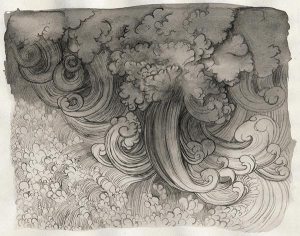
I saw these two deer from a distance and got a few photos to use as reference material, but the photos really weren’t great for just copying as they were. Between being on a moving train, to the sky being overcast with poor lighting, and using an old manual focus lens at a distance, I’m just happy that I got anything useable. So here’s an example of using a reference photo or two just as a reference that I can adjust while drawing, rather than something to slavishly copy.

To start with, the original crooked photo was cropped and edited a bit for contrast and sharpness. Then, I decided the tree on the right should be much closer in, because otherwise it wouldn’t have even been in the framing of the drawing. The viewing angle in the drawing was also lowered from the original photo so more vaguely vegetated background would be visible, because at the original angle none of the background would have appeared on the page. The far left foreground tree was added to give a little weight to that side of the drawing, hoping to help the composition, and a second deer was added so the scene would be a little less empty. The composition really wasn’t thought out as well as it should have been though.

This is a crop of another photo taken a moment later after the two deer started moving away, which was when I realized that there was a second deer. I’m not sure which of these two deer was in the first photo, so I may have just drawn the same one twice. That’s a useful approach because a few photos of the same animal in different poses can be drawn later even as an entire herd.
Back when I was in school I remember feeling like drawing just from imagination was what I should always try to do, because people would always ask if I had made something “out of your head” and would always act more impressed if that was the case. The result of always doing that was things didn’t really look right, or even recognizable, because I didn’t have a good understanding of how they actually did look. That’s gained from practice and thorough study, not from just making things up based on how you think they should look.
Since then I’ve kind of gone the other direction and often feel like I can’t draw anything if I’m not looking at something. Then I often just copy what’s there. I think the real point and usefulness of reference photos is to have something that you can conveniently look at later for ideas or to see the details of how something naturally looks, but then to build a composition from that, not to just copy the references in a way that’s only transferring the image from one medium into another.
















